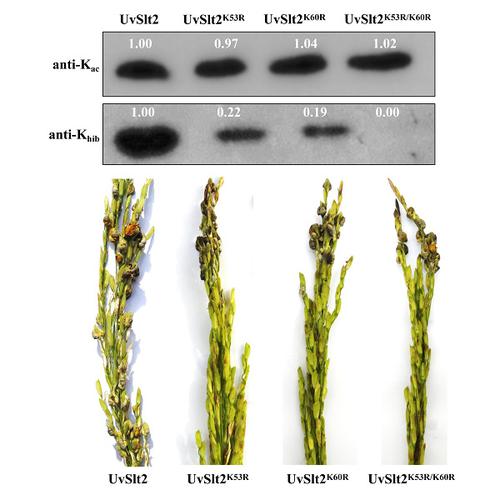当前位置:
X-MOL 学术
›
J. Integr. Plant Biol.
›
论文详情
Our official English website, www.x-mol.net, welcomes your
feedback! (Note: you will need to create a separate account there.)
Comprehensive identification of lysine 2‐hydroxyisobutyrylated proteins in Ustilaginoidea virens reveals the involvement of lysine 2‐hydroxyisobutyrylation in fungal virulence
Journal of Integrative Plant Biology ( IF 9.3 ) Pub Date : 2021-01-11 , DOI: 10.1111/jipb.13066 Xiaoyang Chen 1 , Xiabing Li 1 , Pingping Li 1 , Xiaolin Chen 1 , Hao Liu 1 , Junbin Huang 1 , Chaoxi Luo 1 , Tom Hsiang 2 , Lu Zheng 1
Journal of Integrative Plant Biology ( IF 9.3 ) Pub Date : 2021-01-11 , DOI: 10.1111/jipb.13066 Xiaoyang Chen 1 , Xiabing Li 1 , Pingping Li 1 , Xiaolin Chen 1 , Hao Liu 1 , Junbin Huang 1 , Chaoxi Luo 1 , Tom Hsiang 2 , Lu Zheng 1
Affiliation

|
Lysine 2‐hydroxyisobutyrylation (Khib) is a newly identified post‐translational modification (PTM) that plays important roles in transcription and cell proliferation in eukaryotes. However, its function remains unknown in phytopathogenic fungi. Here, we performed a comprehensive assessment of Khib in the rice false smut fungus Ustilaginoidea virens, using Tandem Mass Tag (TMT)‐based quantitative proteomics approach. A total of 3 426 Khib sites were identified in 977 proteins, suggesting that Khib is a common and complex PTM in U. virens. Our data demonstrated that the 2‐hydroxyisobutyrylated proteins are involved in diverse biological processes. Network analysis of the modified proteins revealed a highly interconnected protein network that included many well‐studied virulence factors. We confirmed that the Zn‐binding reduced potassium dependency3‐type histone deacetylase (UvRpd3) is a major enzyme that removes 2‐hydroxyisobutyrylation and acetylation in U. virens. Notably, mutations of Khib sites in the mitogen‐activated protein kinase (MAPK) UvSlt2 significantly reduced fungal virulence and decreased the enzymatic activity of UvSlt2. Molecular dynamics simulations demonstrated that 2‐hydroxyisobutyrylation in UvSlt2 increased the hydrophobic solvent‐accessible surface area and thereby affected binding between the UvSlt2 enzyme and its substrates. Our findings thus establish Khib as a major post‐translational modification in U. virens and point to an important role for Khib in the virulence of this phytopathogenic fungus.
中文翻译:

全面鉴定Ustilaginoidea virens中的赖氨酸2-羟基异丁酰化蛋白揭示了赖氨酸2-羟基异丁酰化参与真菌毒力。
赖氨酸2-羟基异丁酰化(K hib)是新近鉴定的翻译后修饰(PTM),在真核生物的转录和细胞增殖中起重要作用。但是,其功能在植物致病真菌中仍然未知。在这里,我们使用基于串联质量标签(TMT)的定量蛋白质组学方法对水稻假黑穗病真菌Ustilaginoidea virens中的K hib进行了全面评估。在977种蛋白质中总共鉴定出3 426个K hib位点,表明K hib是U. virens中常见且复杂的PTM 。。我们的数据表明2-羟基异丁酰化蛋白参与了多种生物过程。对修饰蛋白的网络分析表明,它具有高度相互联系的蛋白网络,其中包括许多经过充分研究的毒力因子。我们证实,Zn的结合减少钾dependency3型组蛋白脱乙酰酶(UvRpd3)是主要的酶,其去除2- hydroxyisobutyrylation和乙酰化在U.霉。值得注意的是,K hib的突变丝裂原激活的蛋白激酶(MAPK)UvSlt2中的位点显着降低了真菌毒力并降低了UvSlt2的酶活性。分子动力学模拟表明,UvSlt2中的2-羟基异丁酰化作用增加了疏水性溶剂可及的表面积,从而影响了UvSlt2酶及其底物之间的结合。因此,我们的发现将K hib确立为U. virens的主要翻译后修饰,并指出K hib在这种植物病原性真菌的毒性中具有重要作用。
更新日期:2021-02-12
中文翻译:

全面鉴定Ustilaginoidea virens中的赖氨酸2-羟基异丁酰化蛋白揭示了赖氨酸2-羟基异丁酰化参与真菌毒力。
赖氨酸2-羟基异丁酰化(K hib)是新近鉴定的翻译后修饰(PTM),在真核生物的转录和细胞增殖中起重要作用。但是,其功能在植物致病真菌中仍然未知。在这里,我们使用基于串联质量标签(TMT)的定量蛋白质组学方法对水稻假黑穗病真菌Ustilaginoidea virens中的K hib进行了全面评估。在977种蛋白质中总共鉴定出3 426个K hib位点,表明K hib是U. virens中常见且复杂的PTM 。。我们的数据表明2-羟基异丁酰化蛋白参与了多种生物过程。对修饰蛋白的网络分析表明,它具有高度相互联系的蛋白网络,其中包括许多经过充分研究的毒力因子。我们证实,Zn的结合减少钾dependency3型组蛋白脱乙酰酶(UvRpd3)是主要的酶,其去除2- hydroxyisobutyrylation和乙酰化在U.霉。值得注意的是,K hib的突变丝裂原激活的蛋白激酶(MAPK)UvSlt2中的位点显着降低了真菌毒力并降低了UvSlt2的酶活性。分子动力学模拟表明,UvSlt2中的2-羟基异丁酰化作用增加了疏水性溶剂可及的表面积,从而影响了UvSlt2酶及其底物之间的结合。因此,我们的发现将K hib确立为U. virens的主要翻译后修饰,并指出K hib在这种植物病原性真菌的毒性中具有重要作用。











































 京公网安备 11010802027423号
京公网安备 11010802027423号